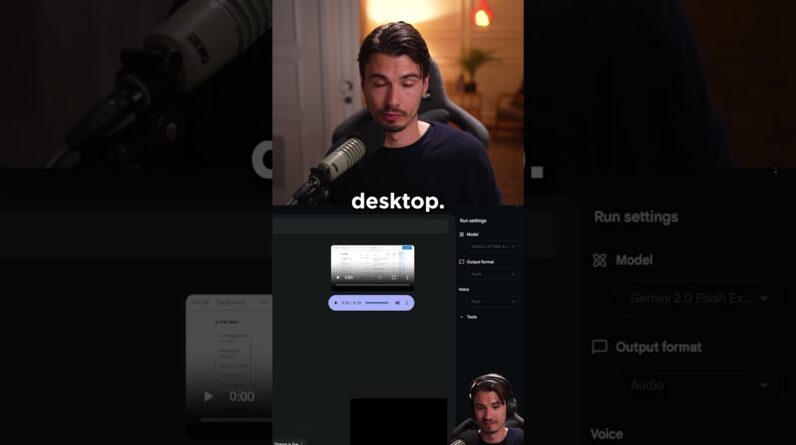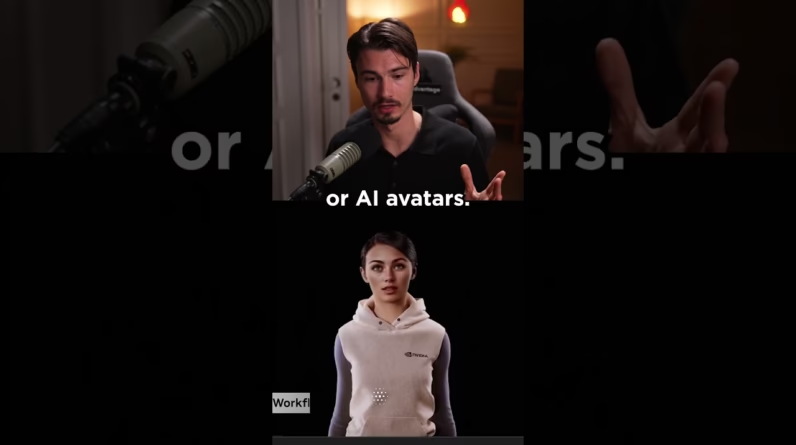
Exciting advancements in artificial intelligence are transforming how you interact with technology. Recently, both Google and OpenAI equipped their leading AI models with “live vision” capabilities, enabling them to process and understand real-time video, just like human eyes. This significant leap opens up new possibilities for everyday tasks, making it easier and more intuitive to engage with your devices.
In this article, you’ll discover how these upgrades allow AI to see your world, from recognizing objects to providing assistance based on what it observes. You will also learn about the features of top models like Gemini 2.0 and ChatGPT’s advanced voice mode, showcasing the practical applications of these innovations and how they can enhance your daily life.
Table of Contents
AI Video Processing: A Comprehensive Overview

Introduction to AI Video Processing
Defining AI Video Processing
AI video processing refers to the integration of artificial intelligence techniques in the analysis and manipulation of video content. This technology allows computers to interpret video feeds in real time, improving automation across various fields such as surveillance, healthcare, and smart cities. In simpler terms, AI video processing enables your devices to “understand” what they see, mimicking human perception and decision-making abilities.
Historical Context: How Video Processing Evolved
The journey of video processing began with basic digital image processing techniques in the 1960s. Over the decades, advancements in hardware and software led to improved video capture and processing capabilities. The introduction of machine learning and deep learning in the 2010s dramatically accelerated this evolution, enabling faster processing speeds and more sophisticated analysis. Today, AI video processing has come a long way, evolving from simple editing tools to complex systems capable of real-time interpretation.
Importance of Real-Time Capabilities
Real-time capabilities in AI video processing are crucial because they allow for immediate reactions to what is being observed. Whether it’s detecting a thief in a surveillance feed or monitoring a patient’s health via video, the ability to act rapidly can make a significant difference. Real-time processing ensures that urgent situations are addressed promptly, enhancing safety and improving operational efficiency across industries.
Technological Advances in AI Video Processing
The Role of Machine Learning and Computer Vision
Machine learning and computer vision are the cornerstones of AI video processing. Machine learning algorithms analyze patterns and make predictions from video data, while computer vision helps machines understand and interpret visual information. Together, they enable functionalities such as facial recognition, object detection, and motion tracking, all of which enhance the utility of AI in video technology.
Integration of Real-Time Data Analysis
Integrating real-time data analysis into AI video processing allows systems to continuously learn and adapt. By analyzing live video feeds, AI can identify anomalies or changes in the environment instantly. This capability is useful in various applications, from improving safety in public spaces to optimizing traffic flow in smart cities.
Enhancements in Processing Speed and Efficiency
Advancements in processing speed and efficiency have made AI video processing more accessible. Innovations in hardware, such as GPUs and specialized chips for AI tasks, combined with algorithmic improvements, allow for faster analysis of high-definition video feeds. This has not only increased accuracy but also broadened the potential applications across sectors.
Understanding Live Vision Features
How Live Vision Works
Live vision features enable AI models to process and interpret live video feeds directly from cameras or smartphones. By utilizing advanced algorithms, they can analyze what’s happening in real time—detecting faces, recognizing objects, and even understanding complex scenes. You can think of it as giving AI the ability to see and interpret the world around you, just like you do.
Key Players: Google and OpenAI’s Contributions
Both Google and OpenAI have made significant strides in integrating live vision capabilities into their AI models. Google’s Gemini 2.0 and OpenAI’s ChatGPT have recently introduced features that enable real-time visual processing. These contributions highlight the growing interest in developing AI models that can adapt to live environments, making them not just conversational entities, but also visual interpreters.
Exploring Real-Time Object Detection and Recognition
Real-time object detection and recognition is a game-changer in AI video processing. You can now have systems that identify and classify objects or people on-the-fly, which has applications ranging from security surveillance to interactive marketing around retail stores. By leveraging vast datasets and machine learning, AI can become more proficient at recognizing everyday objects, environments, and activities.
Applications of Live Video Processing
Surveillance and Security Systems
In the realm of surveillance and security, live video processing is transforming how you monitor spaces. This technology enables automated alerts for suspicious behavior, enhances monitoring efficiencies, and provides law enforcement with vital information rapidly. You can rest assured knowing that AI can assist in making environments safer.
Healthcare Innovations: Remote Monitoring
AI-driven live video processing also plays a pivotal role in healthcare. With remote monitoring using video feeds, doctors can observe patients in real time, ensuring better care without the need for constant physical check-ups. This is particularly beneficial for elderly care or chronic illness management, allowing healthcare providers to keep a close eye on patients from afar.
Smart Cities and Traffic Management
Smart cities leverage live video processing to manage traffic flows better and enhance urban living. Through real-time monitoring, city planners can analyze traffic patterns, make adjustments on-the-go, and reduce congestion. You can envision a future with streamlined traffic that allows your daily commute to be much smoother and quicker.
Impact on Various Industries
Entertainment: Enhancing Live Streaming
In the entertainment sector, live video processing is enhancing live streaming experiences. With AI, platforms can automatically adjust video quality based on your connection, highlight key moments in live broadcasts, and even provide personalized viewing recommendations. This makes your engagement with streaming content richer and more enjoyable.
Education: Revolutionizing Virtual Learning
AI video processing is transforming education, particularly in virtual learning settings. Real-time video processing enables interactive tools for educators, allowing for more engaging and responsive learning environments. Students can participate in classes with instant feedback and interactive elements, making online education more impactful than ever.
Retail: Personalized Shopping Experiences
In retail, live video processing is paving the way for personalized shopping experiences. Imagine walking into a store and being greeted with tailored recommendations based on current trends or past preferences—this is now becoming a reality. Retailers can analyze customer movements and interactions, providing a more customized experience for shoppers like you.
Ethical Considerations and Challenges
Privacy Concerns with Live Video Surveillance
The rise of AI video processing brings with it significant privacy concerns, particularly regarding surveillance. While these technologies enhance safety, they also potentially infringe upon individual privacy rights. As a user, it’s critical to be aware of how your data and video feeds are being utilized, ensuring that ethics and privacy are prioritized.
Bias in AI Algorithms: Addressing Inequality
Another challenge lies in bias within AI algorithms used for video processing. If the data used to train these systems is biased, it can lead to unfair treatment and unequal opportunities. Addressing these biases is essential to ensure that video analysis technologies work equitably for everyone, not just a select group.
Regulations Surrounding AI in Video Processing
Navigating the regulatory landscape around AI video processing is vital. Governments and organizations are beginning to implement policies to govern how this technology is used, especially in sensitive areas like surveillance. Understanding these regulations can help you navigate the complexities and ensure ethical use of AI in your projects.
Future Prospects of AI and Live Video
Predictions for AI Advancements in Video Processing
Looking forward, you can expect further advancements in AI video processing, particularly with features like high-definition analysis and enhanced interactivity. AI will continue to evolve, offering even more sophisticated tools for real-time video analysis, making devices smarter and more capable.
Potential New Markets and Applications
The range of applications for AI video processing is broadening. Emerging markets, such as autonomous vehicles, wildlife monitoring, and interactive gaming, present exciting opportunities for innovation. As technology develops, the possibilities for how AI can enhance live video processing will continue to expand.
The Role of AI in Augmented and Virtual Reality
AI will play an integral role in the advancement of augmented reality (AR) and virtual reality (VR). By facilitating real-time interactions between the digital and physical worlds, AI video processing can create immersive experiences that enhance learning, gaming, and even virtual shopping. You can look forward to a future where these technologies blend seamlessly into your everyday life.
User Accessibility and Tools
Overview of User-Friendly AI Video Tools
Advancements in AI video processing have led to a variety of user-friendly tools. These applications allow users—regardless of their tech skills—to harness the power of AI video analysis for personal or commercial use. From basic video editing to intelligent surveillance solutions, you have options that make AI accessible.
No-Code Development Platforms for AI Integration
No-code development platforms have emerged as game-changers, allowing you to create apps using AI video processing without needing to understand programming languages. These platforms empower you to integrate sophisticated AI functionalities into your projects quickly and easily, democratizing technology and fostering innovation.
Resources for Developers and Non-Developers Alike
Numerous resources are available for both tech-savvy developers and those without coding experience. Whether you are looking for tutorials, community forums, or project templates, plenty of information can guide you in leveraging AI in video processing. This accessibility encourages creativity and experimentation as you explore the capabilities of these tools.
Comparative Analysis of AI Models
A Look at Google’s Gemini 2.0 vs. OpenAI’s ChatGPT
When comparing Google’s Gemini 2.0 and OpenAI’s ChatGPT, you will find both models excel in their capabilities but focus on different strengths. Gemini is optimized for real-time video processing, making it a robust choice for applications requiring immediate analysis. In contrast, ChatGPT shines in conversational contexts, providing rich, context-aware interactions.
Performance in Real-Time Scenarios
In real-time scenarios, Gemini 2.0 stands out with its speed and ability to interpret complex visual data on the fly. ChatGPT, while not primarily designed for real-time video processing, still performs admirably in applications combining text and visual data, though it may not equal the efficiency seen in Gemini.
Strengths and Weaknesses of Each Model
Each model has its strengths and weaknesses based on what you aim to achieve. While Gemini excels in video analysis and object recognition, ChatGPT offers deep language understanding and conversation capabilities. The choice between them ultimately depends on the specific requirements of your project.
Conclusion
Recap of the Impact of AI in Video Processing
AI video processing has revolutionized the way we interact with video data, enhancing capabilities in real-time analysis, surveillance, healthcare, and beyond. Its impact is felt across numerous industries as it continues to evolve, offering new opportunities for improvement and innovation.
The Importance of Continuous Development
As AI technology advances, continuous development and ethical considerations will play crucial roles in shaping the future. Striking a balance between leveraging AI’s capabilities and protecting privacy rights is essential for fostering trust and ensuring widespread adoption.
Final Thoughts on Future Innovations
The future of AI video processing is bright, with numerous innovations on the horizon. By staying informed and exploring new tools, you can engage with this technology responsibly, making empowered decisions that shape how you interact with the world and leverage AI’s potential. Embrace the possibilities, and look forward to a future where video processing enhances your experiences like never before.







